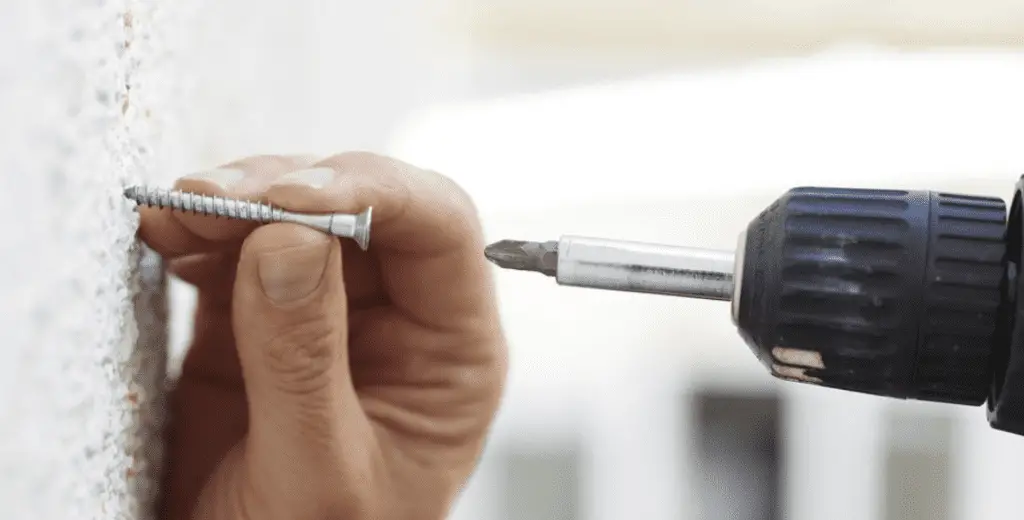For some reason, if you have only wood screws available. Want to hang something on a brick wall, concrete wall, or masonry for example.
Here is what you need to know about using wood screws in a concrete wall.
Wood screws have a coarse thread, allowing them to bite into the wood grains to provide a strong grip. Screws longer than 1.25 inches can have unthreaded portions. A useful feature for joining wood boards.
Using wood screws on concrete will make up things bad in the long run. Concrete walls don’t hold up well the extremely coarse and sharp threads. Most likely, the wall will get damaged if you push to install wood screws, and the potential of holding weight using wood screws will be less than what the masonry screw can provide.
Table of Contents
Reasons to avoid using wood screws in concrete?
- Wood screws have sharp threads supposed to bite into wood grains. Concrete walls can be damaged.
- Wood screws have sharp tips when inserted into concrete they may fall
- Wood screws typically come up in long sizes.
- Wood screws are tapered, cannot hold on concrete walls.
- Wood screws have flat heads, inserting them on concrete can damage the surface.
What will happen if you drill wood screws in concrete?
In a general sense. Nothing that bad will happen. If you want to insert wood screws into concrete. You’re good to go. Even you can insert every type of screw-in whichever material you wish.
However, by looking at the very smaller details. Such that damage on the surface, screws cannot hold enough strength. Also, the longevity the screws offer typically sank down when used interchangeably.
Thus, always be sure to insert the right screws in the right material to get things just perfect. And to save yourself from troubles to come.
How to drill a screw into concrete?
Use masonry screws
For drywall, concrete, the masonry screws work well. Unlike wood screws these are not self-tipping as rather have a flat tip, needing pilot holes to insert them.
Choosing the right bit
Check the head, hex, philps, or crossed. Not every screwdriver driver satisfies all types of heads up. Choose the drill or manual screwdriver that can fit onto the head. A thing to notice before making a purchase for screws.
Mark Your Surface
Mark the spot on the concrete where the hole will be drilled. Be careful not to puncture or damage anything behind the concrete such as wires, pipes, etc.
Prepare Your Drill
Prepare yourself, wear glasses to protect your eyes from dust coming off from the walls. While making pilot holes, the hole should be wide enough. And It is recommended that the end depth of the hole should be set 1/4 inch further than the screw size.
Use Anchors If Required
A screw anchor may be needed if you aren’t using the right screws or the hole is bigger than you anticipated. Anchors can help make a tight bond as they expand from the inside of the hole. Ensuring maximum strong ability.
Recommended screws to use in concrete or masonry
Pavement and brick fall under the category of masonry. You can use masonry screws for such surfaces.
The screws are designed and intended to be used in masonry directly without the need for lag shields, plugs, or other anchor systems.
Tapcon is one of the brands, making use of a medium thread and two separate thread spirals at varying heights between the shank and the edge.
In addition to the four-sided chisels, they have hardened & coated blades to prevent corrosion.
Following are some types of screws intended to insert in concrete or masonry.
- Drop-In Anchors.
- Lag Shield Anchors.
- Sammys Hanging Anchors.
- Hammer Driven Pin Anchor.
- Toggle Wing Anchors.
- Double Expansion Shield Anchor.
- Sleeve Anchors.
- Wedge Anchors.
Some popular types of screws
WOOD SCREWS
Wood screws are known for their coarse threads that grip wood securely until the top of the screw shaft, just under the head, is smooth. A unique design that allows two wooden boards to make a proper joint- the unthreaded part helps joint woods to move while the threaded part bite into the wood. Choose the length that can go deep by 2/3 of a wood board.
One of the identical properties of there is “self-tapping,” no more predrilling holes are needed. The flatheads are equally popular for these screws. The reason being here, to make the heads invisible.
DRYWALL SCREWS
Screws of this type are only designed for installing drywall panels and range from 1 inch to 3 inches in length. Unlike wood screws, heads are not flat just for a reason to avoid damaging the beauty of drywall panels. Inserting them keeps the surface smooth and undamaged. The self-tapping ability makes the job done faster.
MASONRY SCREWS
To insert a masonry screw, you must predrill a hole before inserting it as they cannot bore their own holes since the tip is flat. Speaking of heads, that can vary from hex-head to Philip’s heads, choosing the right head depends on the type of drill you have in your workplace.





